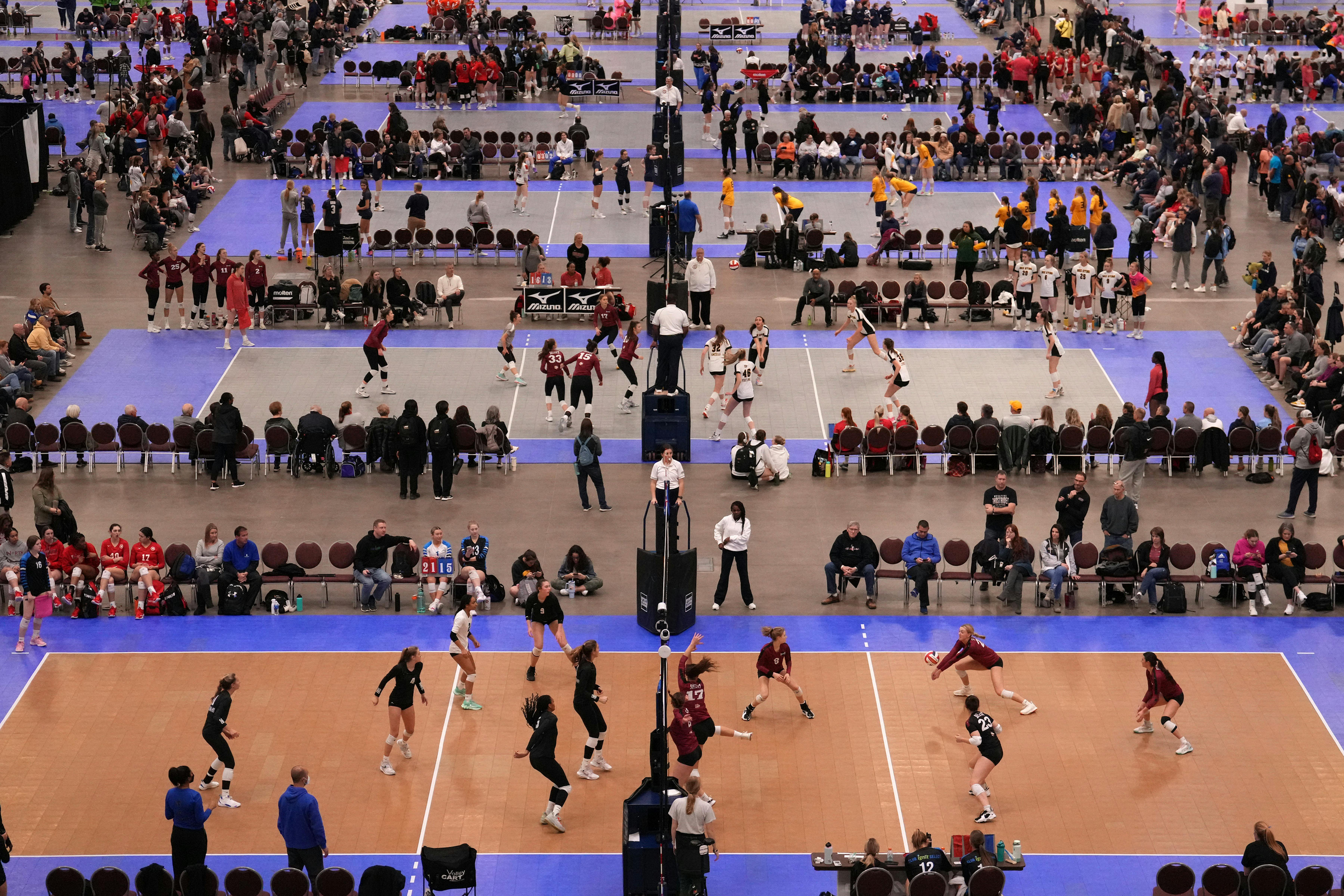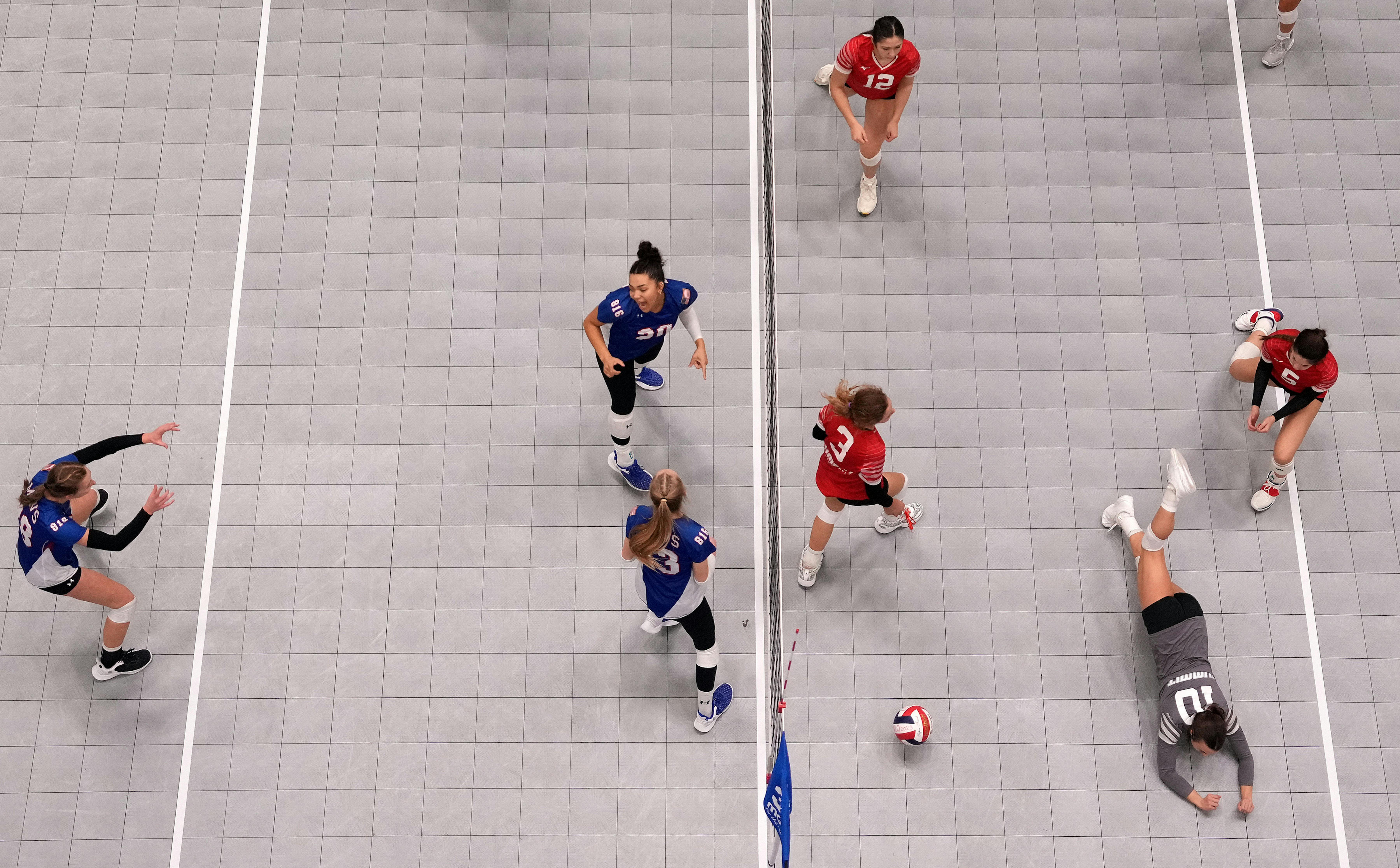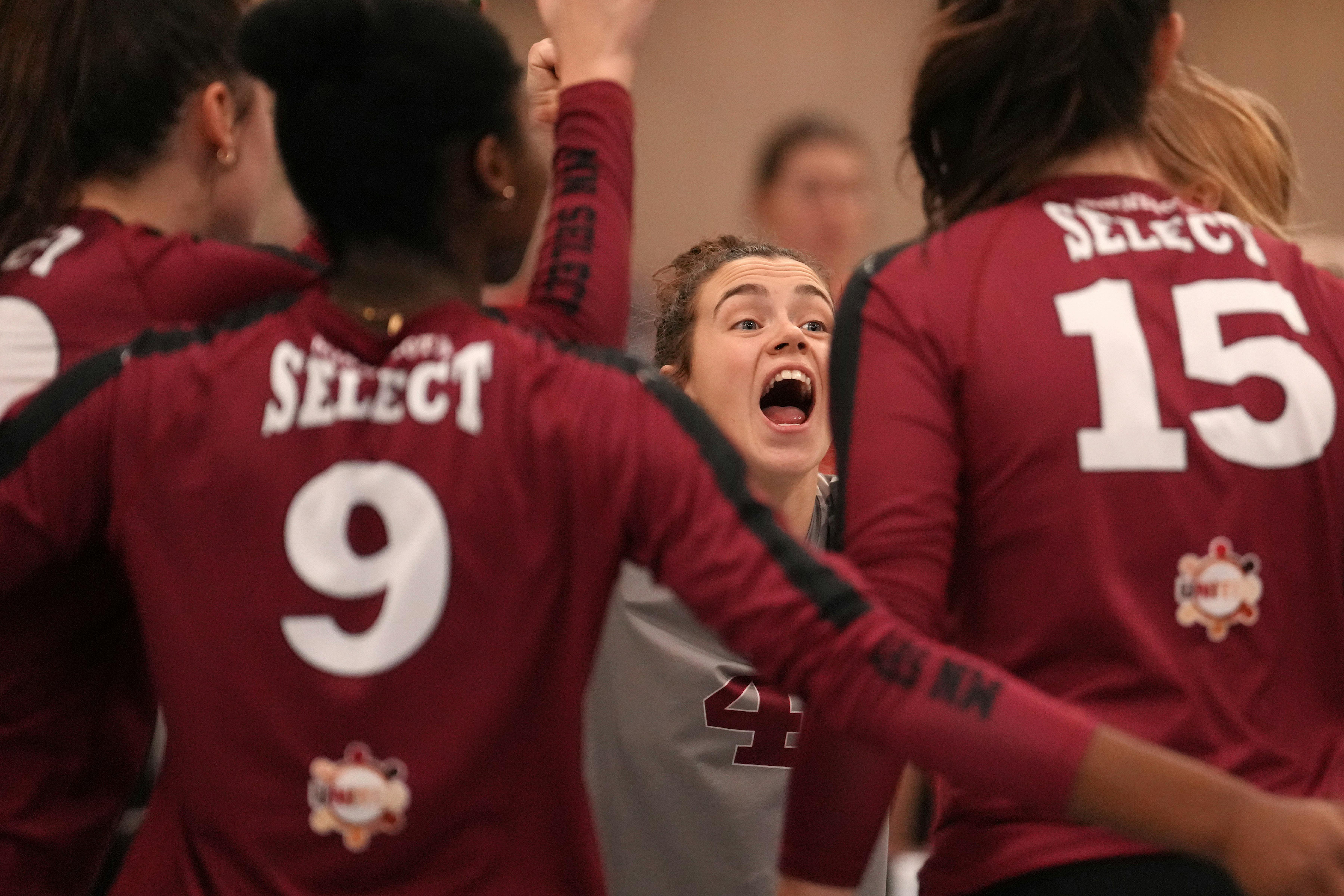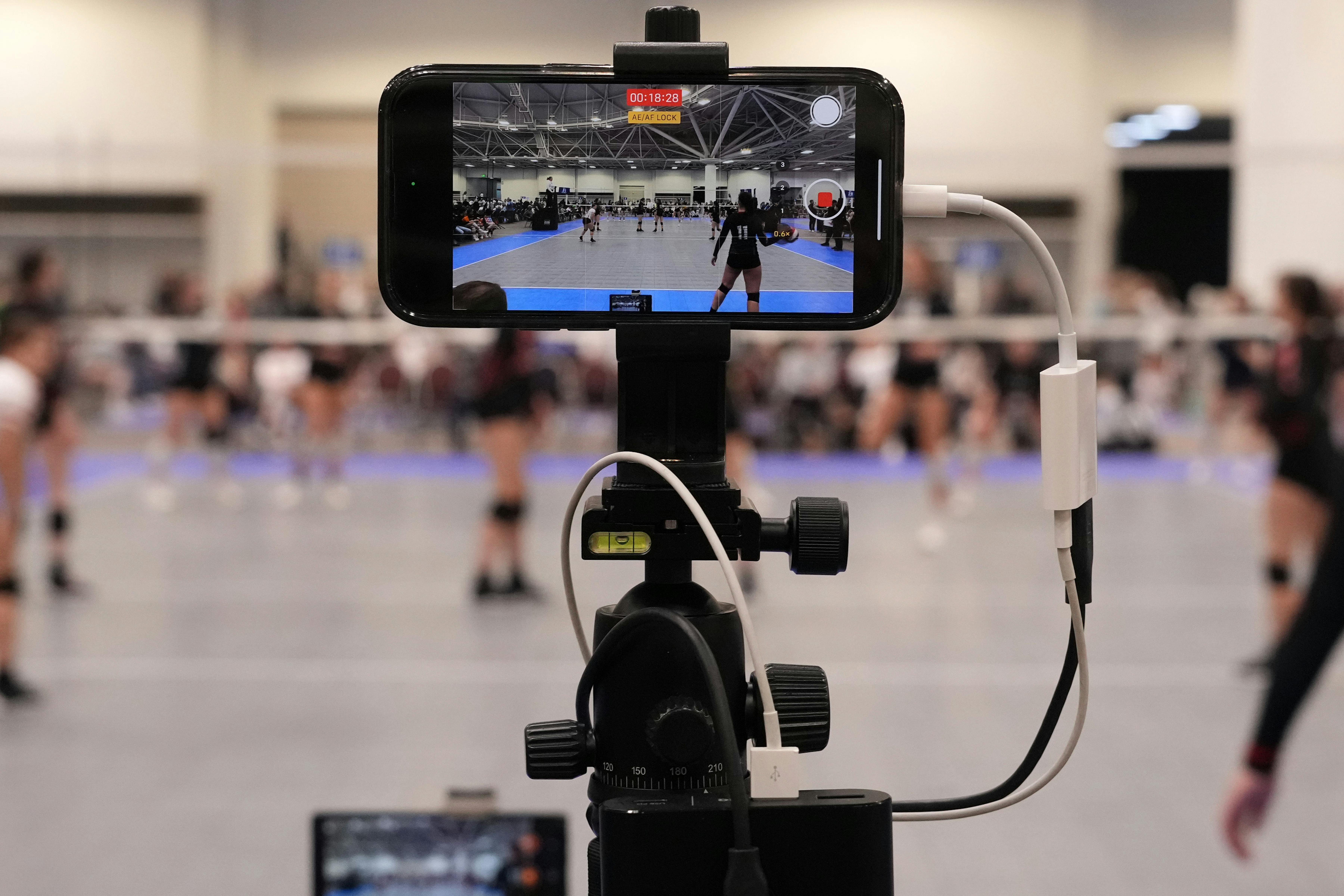The chaos began before sunrise. Fresh snow had fallen overnight, and the sidewalks around the Minneapolis Convention Center were silent.
Inside was a different story.
The 2023 Mizuno Northern Lights Qualifier and January Thaw volleyball tournament were already underway at 7:30 a.m., and the scene for anyone unfamiliar with the expansive reality of club volleyball was incomprehensible.
Thousands of teenage volleyball players from around the country were scattered around 41 courts laid out in three cavernous halls.
Packs of girls waiting to play roamed thin sideline aisles with casual anticipation in color-coordinated sweatsuits. Bodies twisted to make room in tight spaces, selfies were snapped with lightning efficiency, parents stood chatting with early morning energy stirred by sleeved cups of coffee.
As far as the eye could see, volleyballs traced lofty, unending arcs as teams warmed up — a mad science experiment, electrons around some unseen nucleus. If you were not prepared, a wayward ball could torch you. Thrust into this reality, the mind recoiled.

And then came the whistles.
Imagine a referee blowing a whistle. Now imagine every whistle you have heard in your life being blown all at once. That was the sound inside the convention center. It would not stop for three days.
Over the course of that January weekend — and on weekends like it, or bigger, in spring and summer — more than 1,100 matches would be played by more than 3,000 girls from 22 states, Washington, D.C., and Puerto Rico, with thousands more watching.
It was the club volleyball experience in full swing in a corner of Minneapolis. A flood of money would hit the state via expenses for the tournament and, for traveling teams and families, by way of money paid for flights, food and lodging.
But if you weren't directly involved, you probably had no idea it was happening, and the most common refrain from everyone involved was that, in the world of club volleyball, this event wasn't all that big.
In youth athletics, club volleyball is a cultural and financial behemoth. Arising from a movement in the 1980s to allow offseason athletic training outside of high school teams, it has become the churning engine that has led volleyball to become the No. 1 team participation sport for girls in America.
In Minnesota, that participation finds an outlet through the continued expansion and creation of club programs.
Northern Lights, which has decades of experience as one of the first and most successful programs in the state, hosts three annual qualifiers at the convention center for different age groups to reach the Junior National Championships, which are run by USA Volleyball.
Curt Glesmann and Adam Beamer are its directors; both started coaching volleyball in the 1980s when club was in its infancy. Northern Lights was formed in 1993.
"When we first started out we would have six teams and there were only 18s, 16s and 14s age division," Beamer said. "Now it's 10s through 18s, and there is an age division for each of them. We'll have three to seven teams at each level. It has just gotten bigger year after year."
This year Northern Lights has 37 teams.
They operate out of a training facility in Burnsville that was designed by Glesmann. Examples of his fastidiousness: When the courts were constructed he had them sunk lower than the rest of the building's floor so extra padding could be added, and he had fiberglass blown into air holes in the ceiling to deaden the shriek of whistles.
But it is the hosting of the national qualifiers at the convention center — an idea Glesmann brought to life in 1999 — that sets Northern Lights apart.
Before the qualifier can begin, Northern Lights has to determine which teams are accepted, organize the seeds and the schedule — for the January tournament, 1,100 matches in about 55 hours — and facilitate lodging. Beamer, sitting at his desk and scrolling through endless rows of organizational spreadsheets, would put an actuary to shame.
Next to the training facility is a warehouse holding dozens of skids of sport courts, plastic sections that snap together to form an indoor volleyball court. Each court comes with its own referee stanchion, which weighs hundreds of pounds.
They ship all of those courts and stanchions, along with such tournament ephemera as boxes of medals, scoresheets, lanyards and wristbands, to the convention center. Semitrailers move in shifts to the loading bay while Northern Lights coaches, players and family members help with the unloading and then snap the courts into place.
Glesmann works a forklift. Beamer tapes the entire place to show where each court will be.
It is a massive undertaking for good reason. For the January tournament, entry fees totaled more than $200,000. Northern Lights, a nonprofit, has an operating budget of $4.5 million — about 25% larger than the University of Minnesota volleyball team's budget.
Meet Minneapolis, a group that works to attract events and visitors to the city, noted that these type of youth sporting events were some of the first economic drivers to return to the state after COVID-19 and said the direct economic impact of the Northern Lights qualifiers to Minneapolis is in the millions of dollars.
As matches started, Charity Unongo of Minneapolis was watching her daughter, Miriam, warm up with the Minnesota Select 18-1s ahead of a match with VC United of Illinois.
(Club volleyball is divided into age groups, 18s, 17s, 16s, etc., and there are divisions within those, 1s, 2s, 3s, etc. Each club's top team in each age group is a 1.)
This was Miriam's first year with Minnesota Select, which operates out of Maple Grove. She had played for M1, another Minnesota club, last year. But Select had the top 18s team in Minnesota for 2023 after, as 17s in 2022, the group had finished second in nationals.

"This is the highest level," Charity said. "It lets her get acclimated."
Miriam was receiving expert training. The staff roaming the sidelines was led by George Padjen, an assistant at Concordia (St. Paul) for 20 years who has won nine NCAA Division II championships. Vicki Seliger-Swenson, former longtime Hopkins coach whose daughters Stella and Olivia were on the team, served as an assistant, as did recently college graduated players CC McGraw and Katie Myers of the Gophers and Sydney Hilley of Wisconsin.
Seven of the 14 players selected either first- or second-team All-Metro by the Star Tribune in 2022 were on the Minnesota Select roster — all had committed to Division I college programs.
Kate Thibault, a libero out of Watertown-Mayer heading to Oregon, showed an instinctual understanding of defensive movement. She dived into microgaps for digs before tumbling backward onto her feet, and her serve, a flat, floaty thing, befuddled teams from six different states over the weekend.
The 11 girls on the roster represented nine Minnesota high schools, but Thibault said club is the focal point for player development.
"High school does prepare you for club," she said. "That's how we think of it — it's the warmup for club season."
She was introduced to the sport by her mom and grandpa and realized when she was 10 that it was time to focus on volleyball.
"I played up [in age], way up, and I was still libero, that has never changed," Thibault recalled. "I remember after one tournament I had a gymnastics meet the next day and I was like, 'I just don't want to go to it.' It's been such a crazy experience."
College coaches began scouting her when she was 14.
Scott Jackson started Minnesota Select 20 years ago and has worked to balance its growth with maintaining core philosophies.
"We have to keep it centered on the kids' and the families' experience," said Jackson, who also coaches at Wayzata High School. "You want growth for your kid, you want enjoyment for your kid and then secondary to all of that is that she's on a good team, a productive team.
"But who cares about the second one if you don't do the first?"
This year, Minnesota Select is training more than 600 players on 63 teams, including 20 boys teams.
Top clubs in the state charge thousands of dollars for season fees that generally cover six to eight months of training with two or three practices per week and tournaments nearly every weekend. At current prices, a family could expect to pay over $30,000 for a child to play club volleyball from age 12 to 18. Travel expenses can add thousands more.
At the Northern Lights Qualifier, Charity Unongo said there are two major considerations for club volleyball families: time and money.
"Experientially, for us," she said of her family, "it is a vocation and a sacrifice."
On the court, Miriam, a senior at DeLaSalle who will play at St. Thomas, rose, hung in the air and hammered a spike.
Every player on the Minnesota Select 18-1s roster is committed to a college program, but that team is the outlier. The majority of girls who play club will not receive a college scholarship and their parents will not reap any kind of financial payback.
Laura Bush, former longtime assistant and interim coach for the Gophers, is the executive director of North Country Region Volleyball, which oversees Minnesota, North Dakota, South Dakota and Michigan's Upper Peninsula for USA Volleyball.
She said issues remain amid volleyball's growth. Could season lengths be trimmed so girls can focus on other pursuits? Could travel be lessened to cut fees so players from lower economic classes could participate? Could the focus on college scholarships be more reflective of its unlikely reality?
"There is a mismatch as an educator about what sport provides for youth versus maybe what the end game is for some," she said.
Annie Adamczak-Glavan, a former All-America at Nebraska, has run Club 43 out of Hopkins since 2008. She aims to provide high-level training for her four teams at a reasonable cost with less extensive travel.
"If only 6 percent of the high school athletes play college volleyball, only 6 percent, and we're charging $5,000 to $10,000 per year, why are we doing this?" she asked. "Why aren't we doing it for the 94 percent at $400, giving everybody the benefit of time management, dealing with adversity, being part of a team, being athletic, getting out of the house, doing safe things versus unsafe things, and giving them that culture?"
But Club 43 bucked up against costs this season. Plans to take the 16-1s to a tournament in Chicago and nationals in Orlando brought season fees, with travel included in this instance, to $5,850.
It is simply part of a trend.
A 2021 study by Wintergreen Research estimated the youth sports market at $36.9 billion annually — a revenue figure that dwarfs any professional sports league in the world.
"I'm optimistic but incredibly realistic, I don't think it changes," Bush said about the direction of club volleyball. "The machine has started, the engine is going and there is a lot of money to be made."



Mike Steding of Victoria, relaxing between matches at the convention center, explained the tripod situation.
They stood like sentinels over every court, differing heights and leg widths, with cellphones trapped in tensile clamps.
His daughter, Ashlyn, played 18-1s for Vital Volleyball out of Eden Prairie, and he had been one of the hundreds of parents recording matches and making highlight reels to post on social media to boost recruiting or share with family.
He talked about his daughter's life in the sport and echoed what most parents said that weekend: there were no regrets.
The reasons given varied. It was a safe space for growth. Kids learned responsibility, were taught by someone other than their parents and developed skills beyond the court. Parents got to spend time with their children, some of it mundane but lasting: the moment when a daughter removed her AirPods to have a conversation or gossip with teammates on the way to a tournament.
Ashlyn will play college volleyball at Winona State. Mike recalled a road trip they took to Indianapolis for a weekend tournament last year — 18 hours and 1,200 miles in the car. He commemorated it with a photo of the odometer.
"It's true what they say: The days are long and the years are short," he said.
A few minutes later, the match started and the cacophony eased as everyone settled in around the court. For all the abstract mayhem, it was a weekend to view volleyball in its full magnitude and to understand its allure.
Players tracked the ball. Parents and coaches tracked the players. Everyone watching on the edge of their seat, waiting to see what comes next.

